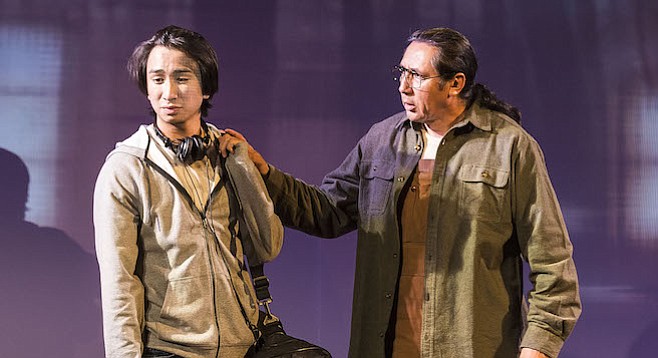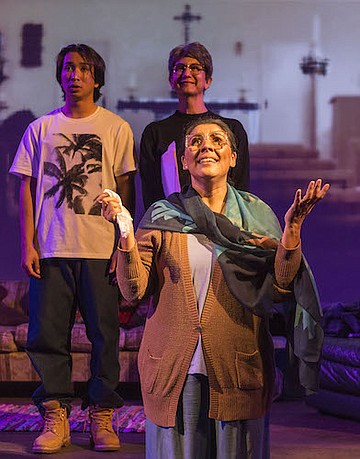 Facebook
Facebook
 X
X
 Instagram
Instagram
 TikTok
TikTok
 Youtube
Youtube

Native Voices at the Autry — aka the Autry Museum of the American West — is the only equity company in America devoted to work by Native Americans. As part of this year’s Resident Theatre Program at the La Jolla Playhouse they are staging Frank Henry Kaash Katasse’s comedy-drama They Don’t Talk Back.
The title draws a line. The play takes place in a small Tlingit fishing village — pop. 200 — in 1994. Native traditions reign: respect for the land, one-on-one relations with nature (salmon, for example, are glad to be netted; they’re part of a larger cycle), and elders deserve respect. So never talk back to them. Nick grew up in Juneau on MTV and hip-hop culture. He’s got baggy pants, his underwear shows, and his black Raiders cap’s on backward. He’s also got tons of ’tude and is against just about everything in the Tlingit culture, especially his grandparents’ seemingly constant demands.
In part because they call him “apple”: red on the outside, white within. His absent father was a native; his mother, a junkie now in jail, is white. Nick’s an outsider at least twice-over. He admits that he’s “too white to be brown, too dark to be bright.”
Early scenes abound with differences. Nick’s adept at Sega Genesis, while cousin Edward (also parentless) still plays old-hat Nintendo and watches a dated WrestleMania battle between Hulk Hogan and the Ultimate Warrior. The grandparents, Paul Sr., and Linda, are fans of The Price is Right. Interspersed with songs, dances, and monologues about Tlinkit culture, the play follows Nick’s gradual acceptance of his new family and growing respect for their culture.
Rather than slow the pace, the interludes give the show life. Duane Minard (adamant and compassionate as Paul, Sr.) chants an elegy/note of hope in Tlingit that binds the piece together.
The playwright has a knack for presenting ethnicity and sociology without giving a lecture. These are character-driven, as when Paul, Sr., talks about syncretism without using the word: “Learn things from white people but from our own people, too.”

Some scenes and monologues need tightening, however, especially when the dialogue becomes stock, he said/she said exchanges without adding information or spark. And the hospital scene loses dramatic force by its length and tried-and-true emotional appeals. The finale’s a keeper that can evoke tears without having to jerk them.
Kholan Studi (son of actor Wes) does riveting work as Edward, be it a monologue about mythical eggs or in exchanges with Roman Zaragoza’s Nick (who moves skillfully from adamant denial to acceptance). As Linda and Nick’s PTSD father Tim, Jennifer Bobiwash and Brian Pagaq Wescott beam on and off, the latter at times stuffing too many choices into a moment.
The design work combines the humble with the sweeping and epic. Sara Ryung Clement’s set, a living room and downstage wooden wharf, and props locate the family above the poverty line but nowhere near mad-money items.
Tom Ontiveros’s projections (three panels on the rear wall) turn Alaska into a living character. At first they are stills of snowy peaks and foggy bays; then, like the play and Alaska itself, they become animated. River currents speed up, waves grow in size, and a storm on the horizon this way comes.


Native Voices at the Autry — aka the Autry Museum of the American West — is the only equity company in America devoted to work by Native Americans. As part of this year’s Resident Theatre Program at the La Jolla Playhouse they are staging Frank Henry Kaash Katasse’s comedy-drama They Don’t Talk Back.
The title draws a line. The play takes place in a small Tlingit fishing village — pop. 200 — in 1994. Native traditions reign: respect for the land, one-on-one relations with nature (salmon, for example, are glad to be netted; they’re part of a larger cycle), and elders deserve respect. So never talk back to them. Nick grew up in Juneau on MTV and hip-hop culture. He’s got baggy pants, his underwear shows, and his black Raiders cap’s on backward. He’s also got tons of ’tude and is against just about everything in the Tlingit culture, especially his grandparents’ seemingly constant demands.
In part because they call him “apple”: red on the outside, white within. His absent father was a native; his mother, a junkie now in jail, is white. Nick’s an outsider at least twice-over. He admits that he’s “too white to be brown, too dark to be bright.”
Early scenes abound with differences. Nick’s adept at Sega Genesis, while cousin Edward (also parentless) still plays old-hat Nintendo and watches a dated WrestleMania battle between Hulk Hogan and the Ultimate Warrior. The grandparents, Paul Sr., and Linda, are fans of The Price is Right. Interspersed with songs, dances, and monologues about Tlinkit culture, the play follows Nick’s gradual acceptance of his new family and growing respect for their culture.
Rather than slow the pace, the interludes give the show life. Duane Minard (adamant and compassionate as Paul, Sr.) chants an elegy/note of hope in Tlingit that binds the piece together.
The playwright has a knack for presenting ethnicity and sociology without giving a lecture. These are character-driven, as when Paul, Sr., talks about syncretism without using the word: “Learn things from white people but from our own people, too.”

Some scenes and monologues need tightening, however, especially when the dialogue becomes stock, he said/she said exchanges without adding information or spark. And the hospital scene loses dramatic force by its length and tried-and-true emotional appeals. The finale’s a keeper that can evoke tears without having to jerk them.
Kholan Studi (son of actor Wes) does riveting work as Edward, be it a monologue about mythical eggs or in exchanges with Roman Zaragoza’s Nick (who moves skillfully from adamant denial to acceptance). As Linda and Nick’s PTSD father Tim, Jennifer Bobiwash and Brian Pagaq Wescott beam on and off, the latter at times stuffing too many choices into a moment.
The design work combines the humble with the sweeping and epic. Sara Ryung Clement’s set, a living room and downstage wooden wharf, and props locate the family above the poverty line but nowhere near mad-money items.
Tom Ontiveros’s projections (three panels on the rear wall) turn Alaska into a living character. At first they are stills of snowy peaks and foggy bays; then, like the play and Alaska itself, they become animated. River currents speed up, waves grow in size, and a storm on the horizon this way comes.
Comments